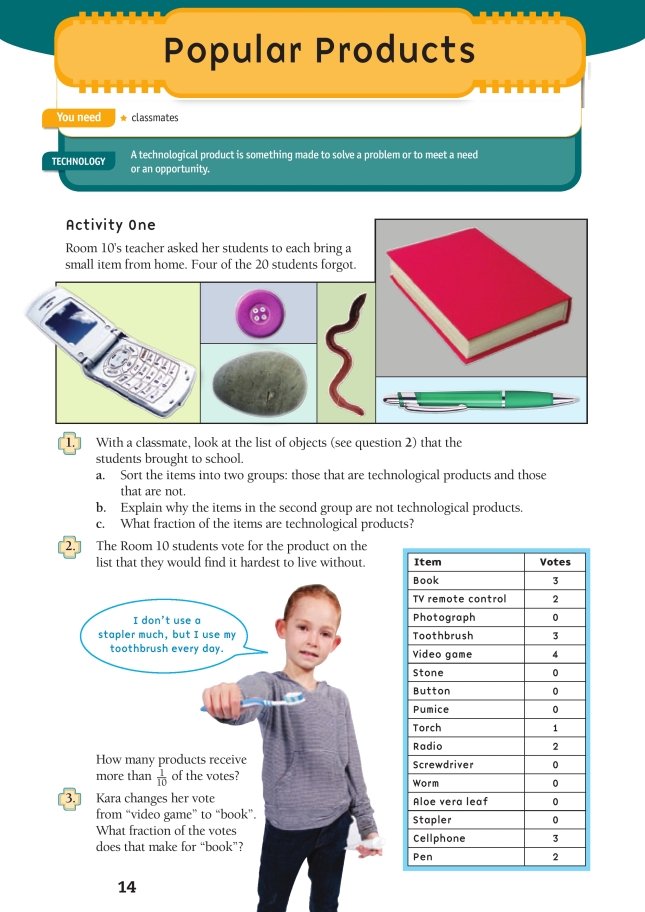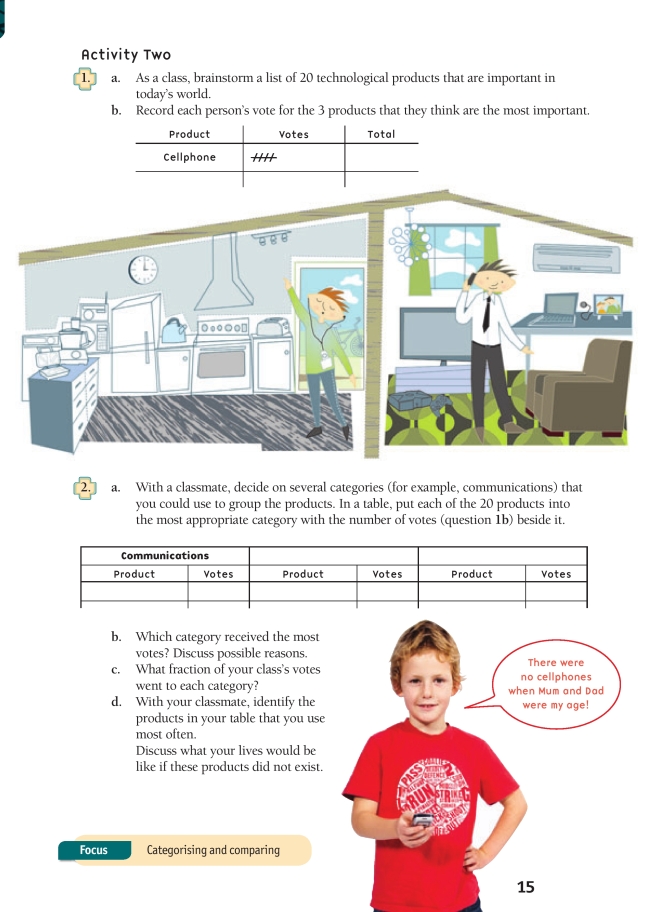Popular Products
This is a level 3 activity from the Figure It Out series.
A PDF of the student activity is included.
Click on the image to enlarge it. Click again to close. Download PDF (704 KB)
Classification in mathematics involves deciding whether objects (for example, numbers or shapes) share a specific property or meet certain criteria, making them distinct from other objects. In these activities, the students classify objects by deciding whether they are technological products or not.
FIO, Technology Rules!, Levels 2+-3+, Popular Products, pages 14 - 15
This activity requires students to identify simple fractions. Using multilink cubes to represent the votes may make it easier for students to work out the fractions. More confident students can simplify their fractions.
For help in developing fractions concepts, see NDP Book 7: Teaching Fractions, Decimals, and Percentages.
Comparing and contrasting ideas develops the key competency relating to others.
Support for English Language Learners
Supporting students with talking about hypothetical conditions and consequences
Language focus: talking about hypothetical conditions and consequences
Complex sentences with “if” are frequently used in Technology Rules! to express real or hypothetical conditions and consequences. (For example, pages 2–3, 6, and 8–9 use real conditions and the correct verb forms for these.)
The last question in Activity Two tells students to talk about the hypothetical situation of products not existing and a consequence of this. One simple way of doing this in English is using the following sentence structure:
- If pens didn’t exist, I would write with pencils.
- If TV remote controls didn’t exist, I wouldn’t change the channel from the couch.
You could support English language learners to use this structure by providing models and explaining and illustrating the following key points:
- The part of the sentence with “if” is the condition (or situation).
- In this case, the condition or situation is imaginary or hypothetical.
- The other part of the sentence (the main clause) is the consequence.
- The verb that follows “if” is in the past form.
- The main clause consists of subject + would/n’t + verb.
Note that there are many variations on this structure (for example, using “should” or “could” instead of “would”). It’s generally best to focus on one structure at a time.
Some students will benefit from using a speaking frame like the one below to help them take part in the discussions.
| Condition | Consequence | ||
| If | __________ didn't exist | I would/wouldn't | __________ |
| If | __________ didn't exist | I would/wouldn't | __________ |
| If | __________ didn't exist | I would/wouldn't | __________ |
Technology-related student activities
- The students explain why birds’ nests, beaver dams, cobwebs, and monkeys using sticks are not technological. They could explore the use of non-technological products in earlier times, such as using cobwebs to stop bleeding. They could also investigate the use of bone to fashion fishhooks, weapons, and ornaments and how artists use bone today and what technology they use to work with it.
- The students examine everyday objects, such as bottle openers, drink tear-tabs, cellphones, cheap spectacles, and batteries, and talk about whether they are fit for purpose. Are there any items that may work sometimes but not always?
- Show pictures of items, for example, candlesticks, earplugs, shoe polish, fish knives, braces, and close-up shots of components of everyday objects, such as bicycle forks and umbrella handles. Ask the students to identify what the purpose of each object is.
Exploring the technology-related context
People involve themselves in technological practice to meet a need, solve a problem, or respond to an opportunity. This can result in an outcome of a product, system, or environment. The concept of fitness for purpose is important, and the outcome needs to do what it was intended to, preferably in a safe and efficient way. Natural products are not technological in themselves, but people use them to design technological outcomes, such as the use of wool in clothing and carpets and to mop up oil spills.
Answers
Activity One
1. a. Technological products: book, TV remote control, photograph, toothbrush, video game, button, torch, radio, screwdriver, stapler, cellphone, pen Not technological: stone, pumice, worm, aloe vera leaf
b. Technological products are developed by people; they are not objects developed naturally. For example, pumice is a type of volcanic rock that is formed naturally in the volcanic eruption process.
c. 12 of the 16 items are technological products, so the fraction is 12/16 or 3/4.
2. Book, toothbrush, video game, cellphone. (1/10 of 20 is 2 votes. These items all received more than 2 votes.)
3. The book now has 4 out of 20 votes, which is 4/20 or 1/5.
Activity Two
1. a.–c. Products, votes, and tallies will vary.
2. a. Categories and tables will vary.
b. Answers will vary.
c. Fractions will vary. To find the fraction, divide the total number of votes for each category by the total number of votes cast (number of people in the class).
d. Choices and discussion will vary.

